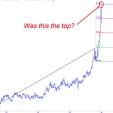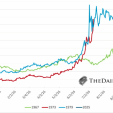Are The Bears Entering Wall Street?
The good news is: There will be great opportunities when this decline is over.
The Negatives: New lows returned in threatening numbers last week.
The first chart covers the past 6 months showing the S&P 500 (SPX) in red and a 40% trend (4 day EMA) of NYSE new highs divided by new highs + new lows (NY HL Ratio), in blue. Dashed vertical lines have been drawn of the 1st trading day of each month. Dashed horizontal lines have been drawn at 10% levels for the indicator, the line is solid at the 50%, neutral level.
NY HL Ratio tagged the neutral line last Monday then headed back downward along with the index.

The next chart is similar to the one above except it shows the NASDAQ composite (OTC) in blue and OTC HL Ratio, in red, has been calculated from NASDAQ data.
OTC HL Ratio went from very bad to worse last week.

The Positives: New lows increased last week, but not to levels high enough to turn the new low indicators downward.
The chart below covers the past 6 months showing the SPX in red and a 10% trend (19 day EMA) of NYSE new lows (NY NL) in blue. NY NL has been plotted on an inverted Y axis so decreasing new lows move the indicator upward (up is good).
NY NL is not the best top indicator (too much lag), but it is still heading sharply upward and it will require more than 228 new lows on the NYSE to turn it downward.

The next chart is similar to the one above except is shows the OTC in blue and OTC NL, in orange, has been calculated from NASDAQ data.
OTC NL is showing a similar pattern to NY NL and it will require more than 209 new lows on the NASDAQ to turn it downward.

Although new low indicators are moving upward, the number of new lows in absolute terms has remained at threatening levels.
Money Supply (M2)
The charts were provided by Gordon Harms.
Money supply growth leveled off last week.

Bull And Bear Markets
My conclusion last week describing the current market activity as a bear market rally generated quite a few comments…mostly pointing out that we were not in a bear market because none of the major indices were down more than 20%. The 20% figure defining a bear market is relatively recent and, I think, useless.
In the 1980’s I developed a theory that a market cycle could be defined as what happens between peaks in the number of new lows. The theory has served me well except in 1999 when the SPX was up about 20% while the mean change of the component issues of the SPX was about -10% for the year. The dichotomy of blue chips outperforming small caps seen at market tops has been the essence of breadth analysis but it usually lasts no more than a few months before a broad based decline in the major capitalization weighted indices begins.
Last week when I said we were experiencing a “bear market rally” I meant the rally was in the down phase of the cycle that was not likely to be over.
Avery Brinkley Jr. is a technical analyst who writes me regularly.
He offered an explicit definition of what to look for in a bottom.
This has been reproduced with his permission.
Weekly Note: Until proved otherwise we are now in a bear market rally. How do I know?
1. There is increasing money flow into utilities and staples and out of aggressive sectors even over the past couple of weeks.
2. Equal weights still lag the large cap weighted indices---note the 'fat' red candle volumes which indicate volume during weeks dominated by selling on the equal weight S&P 500 (RSP) chart below. The total volume on down weeks (selling pressure) is much greater than buying pressure on rallies thus far this year.
3. Prices during oversold conditions have been a mix of volatile consolidation with a few rally days interspersed. In a bull market, once the oversold levels occur, there is prompt buying creating an uptrend rather than the prolonged hesitancy we see now.
4. Despite all the hoopla about banks benefiting from rising interbank lending rates, the banking index ETF is very bearish and has violated prior lows. Some banks may be exposed to low rated corporate bonds which are potentially subject to default going forward. Furthermore, with deterioration in GDP to under 1% last quarter and sequential negative PMI readings, coming recession is quite possible.
5. The HYG---high yield bonds---continue their 'zig zag' downward--and stocks usually follow their lead. Money is rotating into government bonds in spite of historically low yields for perceived capital preservation and a small return. Just keep in mind when rates DO climb at some future time, one loses principal unless holding to maturity. And, most defensive utilities and staples ultimately fall in a bear market. Cash is the only guarantee of capital preservation under such conditions.
I would also emphasize the following observations and rules of thumb:
1. Defensive issues do NOT provide safety of capital in a bear market in the way that cash does.
2. A market bottom has a characteristic signature which is not yet present---no retest of last week's short term recent low has yet occurred, and that low on the S&P 500 held fairly close to the Fall bottom but with much less fear (lower VIX) which is contrarian bearish. Problem is that the charts show lower highs and lower lows on most other indices, and so one cannot turn bullish long-term until that changes.
3. Market internal condition remains treacherous with only 20-30% of stocks on NYSE, NASDAQ and S&P 500 trading above their 200 day EMA’s while bullish percent indices for these three are 29-33%. It is stated by Greg Schnell of Stockcharts.com that based on the prior bear market patterns of 2000 and 2008, a bull market is not possible until BPIs exceed 60-70%. Any bounce which tops out at less than these levels suggests lower lows ahead.
4. Note the negative divergence in SPX daily price and its 1% EMA of advance-decline ratio leading into the bull market top (second chart). The 1% EMA finally just crossed into negative territory which we see during bear markets.
Conclusion
There were alarming numbers of new lows on Wednesday and Friday last week and the secondaries fell to new cycle lows.
I expect the major averages to be lower on Friday February 12 than they were on Friday February 5.
Last week’s positive forecast was a miss.
********
Disclaimer: : Charts and figures presented herein are believed to be reliable but I cannot attest to their accuracy. Recent (last 10-15 yrs.) data has been supplied by CSI (csidata.com), FastTrack (fasttrack.net), Quotes Plus and the Wall Street Journal (wsj.com). Historical data is from Barron’s and ISI price books. The views expressed dare provided for information purposes only and should not be construed in any way as investment advice. Furthermore, the opinions expressed may change without notice.

















